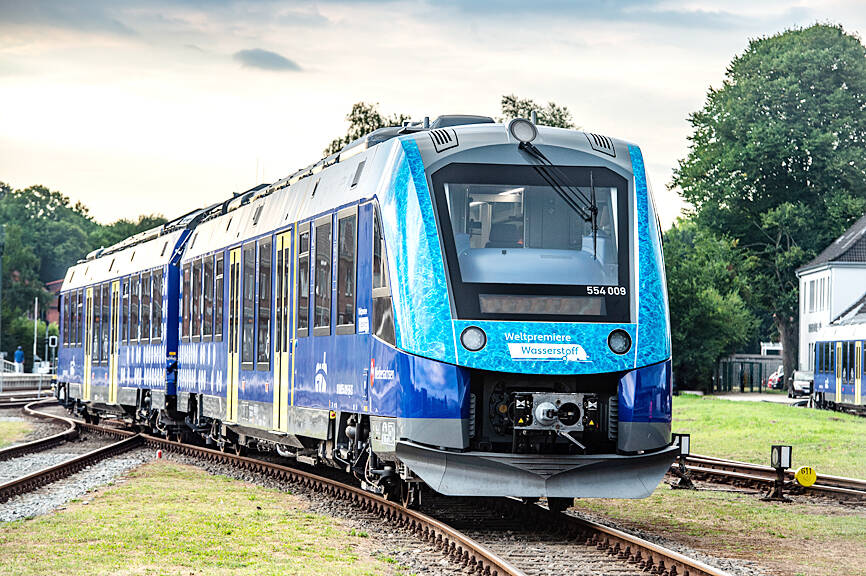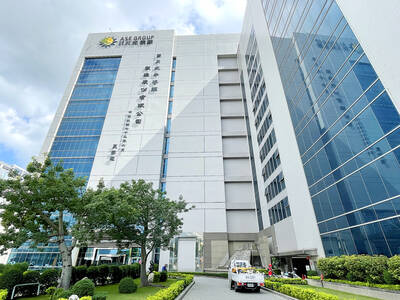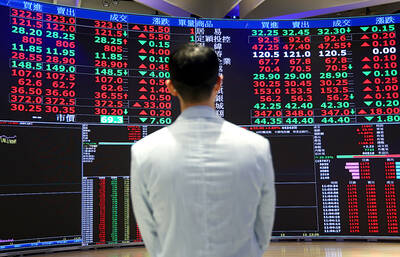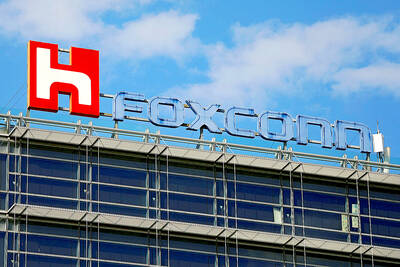Germany on Wednesday inaugurated a railway line powered entirely by hydrogen, a “world premiere” and a major step forward for green train transport, despite nagging supply challenges.
A fleet of 14 trains provided by French industrial giant Alstom SA to the German state Lower Saxony has replaced diesel locomotives on the 100km of track connecting the cities of Cuxhaven, Bremerhaven, Bremervoerde and Buxtehude near Hamburg.
“We are very proud to put this technology into operation together with our strong partners as a world premiere,” Alstom chief executive officer Henri Poupart-Lafarge said in a statement.

Photo: EPA-EFE / Alastom SA
Hydrogen trains have become a promising way to decarbonize the rail sector and replace climate-warming diesel, which still powers 20 percent of journeys in Germany.
Billed as a “zero emission” mode of transport, the trains mix hydrogen on board with oxygen present in the ambient air using a fuel cell installed in the roof. This produces the electricity needed to pull the train.
Regional rail operator Landesnahverkehrsgesellschaft Niedersachsen mbH said the fleet, which cost 93 million euros (US$92,7 million), would prevent 4,400 tonnes of carbon dioxide being released into the atmosphere each year.
RUN FOR ITS MONEY
Designed in the southern French town of Tarbes and assembled in Salzgitter in central Germany, Alstom’s trains — called Coradia iLint — are trailblazers in the sector.
The project created jobs for up to 80 employees in the two countries, Alstom said.
Commercial trials have been carried out since 2018 on the line with two hydrogen trains, but now the entire fleet is adopting the groundbreaking technology. The French group has signed four contracts for several dozen trains between Germany, France and Italy, with no sign of demand waning.
In Germany alone, “between 2,500 and 3,000 diesel trains could be replaced by hydrogen models,” Alstom project manager Stefan Schrank said.
“By 2035, around 15 to 20 percent of the regional European market could run on hydrogen,” said Alexandre Charpentier, a rail expert at consultancy Roland Berger.
Hydrogen trains are particularly attractive on short regional lines where the cost of a transition to electric outstrips the profitability of the route. Currently, about one out of two regional trains in Europe runs on diesel.
However, Alstom’s competitors are ready to give it a run for its money. German behemoth Siemens AG unveiled a prototype hydrogen train with national rail firm Deutsche Bahn AG in May, aiming to roll them out in 2024.
Yet despite the attractive prospects, “there are real barriers” to a big expansion with hydrogen, Charpentier said.
For starters, trains are not the only means of transport hungry for the fuel. The entire sector, whether it be road vehicles or aircraft, not to mention heavy industry such as steel and chemicals, is eyeing hydrogen to slash carbon dioxide emissions.
COLOSSAL INVESTMENT
Although Germany in 2020 announced an ambitious 7 billion euro plan to become a leader in hydrogen technologies within a decade, the infrastructure is still lacking in Europe’s top economy.
It is a problem seen across the continent, where colossal investment would be needed for a real shift to hydrogen.
“For this reason, we do not foresee a 100 percent replacement of diesel trains with hydrogen,” Charpentier said.
Furthermore, hydrogen is not necessarily carbon free: only “green hydrogen,” produced using renewable energy, is considered sustainable by experts. Other, more common manufacturing methods exist, but they emit greenhouse gases because they are made from fossil fuels.
The Lower Saxony line in the beginning would have to use a hydrogen by-product of certain industries such as the chemical sector.
The French research institute IFP, which specializes in energy issues, says that hydrogen is “95 percent derived from the transformation of fossil fuels, almost half of which come from natural gas.”
Europe’s enduring reliance on gas from Russia amid massive tensions over the Kremlin’s invasion of Ukraine poses major challenges for the development of hydrogen in rail transport.
“Political leaders will have to decide which sector to prioritize when determining what the production of hydrogen will or won’t go to,” Charpentier said.
Germany would also have to import massively to meet its needs. Partnerships have recently been signed with India and Morocco, and German Chancellor Olaf Scholz sealed a green hydrogen deal with Canada on a visit this week, laying a path for a transatlantic supply chain.

EXPANSION: The investment came as ASE in July told investors it would accelerate capacity growth to mitigate supply issues, and would boost spending by 16 percent ASE Technology Holding Co (ASE, 日月光投控), the world’s biggest chip assembly and testing service provider, yesterday said it is investing NT$17.6 billion (US$578.6 million) to build a new advanced chip packaging facility in Kaohsiung to cope with fast-growing demand from artificial intelligence (AI), high-performance-computing (HPC) and automotive applications. The new fab, called K18B, is to commence operation in the first quarter of 2028, offering chip-on-wafer-on-substrate (CoWoS) chip packaging and final testing services, ASE said in a statement. The fab is to create 2,000 new jobs upon its completion, ASE said. A wide spectrum of system-level chip packaging technologies would be available at

Taiwan’s foreign exchange reserves hit a record high at the end of last month, surpassing the US$600 billion mark for the first time, the central bank said yesterday. Last month, the country’s foreign exchange reserves rose US$5.51 billion from a month earlier to reach US$602.94 billion due to an increase in returns from the central bank’s portfolio management, the movement of other foreign currencies in the portfolio against the US dollar and the bank’s efforts to smooth the volatility of the New Taiwan dollar. Department of Foreign Exchange Director-General Eugene Tsai (蔡炯民)said a rate cut cycle launched by the US Federal Reserve

HEAVYWEIGHT: The TAIEX ended up 382.67 points, with about 280 of those points contributed by TSMC shares alone, which rose 2.56 percent to close at NT$1,400 Shares in Taiwan broke records at the end of yesterday’s session after contract chipmaker Taiwan Semiconductor Manufacturing Co (TSMC, 台積電) hit a fresh closing-high amid enthusiasm toward artificial intelligence (AI) development, dealers said. The TAIEX ended up 382.67 points, or 1.45 percent, at the day’s high of 26,761.06. Turnover totaled NT$463.09 billion (US$15.22 billion). “The local main board has repeatedly hit new closing highs in the past few sessions as investors continued to embrace high hopes about AI applications, taking cues from a strong showing in shares of US-based AI chip designer Nvidia Corp,” Hua Nan Securities Co (華南永昌證券) analyst Kevin Su

Nvidia Corp’s major server production partner Hon Hai Precision Industry Co (鴻海精密) reported 10.99 percent year-on-year growth in quarterly sales, signaling healthy demand for artificial intelligence (AI) infrastructure. Revenue totaled NT$2.06 trillion (US$67.72 billion) in the last quarter, in line with analysts’ projections, a company statement said. On a quarterly basis, revenue was up 14.47 percent. Hon Hai’s businesses cover four primary product segments: cloud and networking, smart consumer electronics, computing, and components and other products. Last quarter, “cloud and networking products delivered strong growth, components and other products demonstrated significant growth, while smart consumer electronics and computing products slightly declined,” compared with the